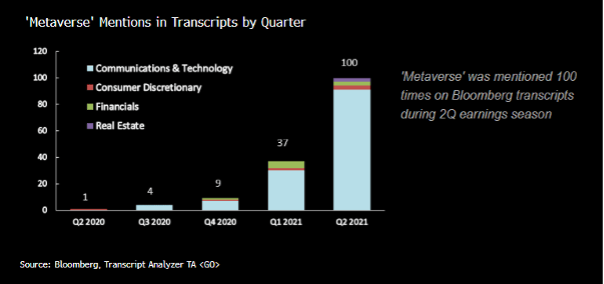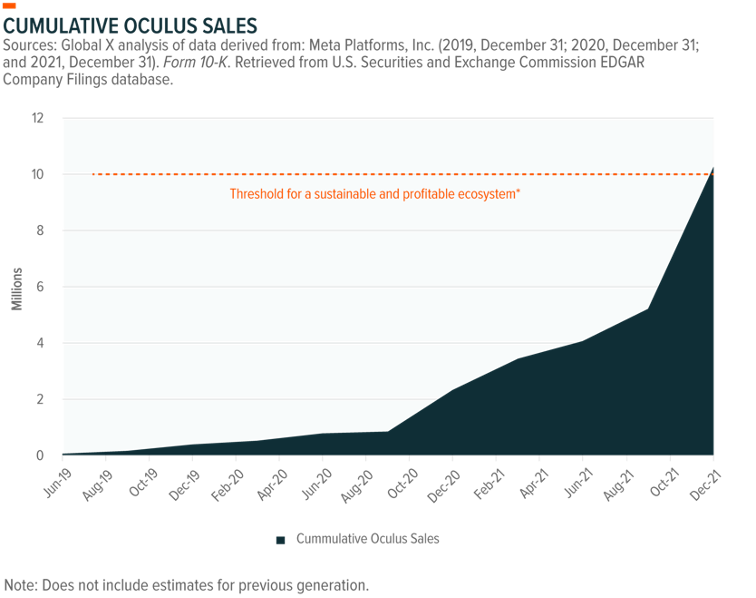Why the FANGs are primed to win the metaverse

Global X ETFs
The metaverse has become one of the hottest investment topics. Yet the theme has left many investors bemused. Some wonder what it is. While others wonder where the investment opportunity may be, given the lack of pureplay metaverse companies.
The metaverse, at its core, is just shared virtual reality (VR) or augmented reality (AR), powered by the internet. It is an internet that you can walk around in, see in 3D, and talk with other people. It’s an internet that instead of just viewing content, you participate in the content.

Where is the opportunity?
Because the metaverse is a broad concept, the nature and size of the opportunity is somewhat in the eye of the beholder. However, analysts from Citi, Goldman Sachs and Morgan Stanley all estimate that the metaverse will have an $8 trillion total addressable market (TAM) this decade. The TAM will grow as 5G goes global and VR headsets and AR smart glasses become cheaper, lighter, and more powerful.
The bulk of this opportunity is forecast to come from two key areas: devices and content. Devices – VR headsets, AR glasses – will be needed to power the metaverse, much like computers are needed to power the internet. And content – such as video games and live entertainment – will be required to give the devices a purpose.
Which companies are best placed?
The companies that are most widely expected to capitalise on this theme are the US tech giants – Facebook, Apple, Nvidia, Google, Microsoft – also known as the FANGMs. These are the stocks most regularly featured in metaverse investment indexes. And the companies most frequently cited by academics as being at its frontier. The reason being they can most easily bridge both these worlds – devices and content – and make the metaverse stick.
Facebook (Meta)
Facebook has been the trailblazer. In 2021, Facebook changed its name to Meta Platforms and went on a hiring spree, aimed at boosting the development of its metaverse products. It’s Oculus Quest 2 headset has hit over 14 million units sold worldwide, making it the bestselling metaverse device. While its Horizons platform aims to provide the content.

Apple
Apple has never confirmed that it is working on a metaverse headset or glasses. But analysts are increasingly putting the pieces together based on the company’s acquisitions, software updates, new hires, and media leaks. Apple has a lot to gain from a metaverse as it can extend its existing empire. Meaning Apple can bring over its existing apps, network of developers, and iPhone users to whatever metaverse device it builds.
Nvidia
Nvidia, the premier microchip designer, is in a unique space for the metaverse. While Nvidia will not make devices as such, its graphics cards will be extensively used in other companies’ headsets. (Facebook recommends them for Oculus). Nvidia is also building metaverse software – which it calls “the Omniverse” – that allows architects, designers, developers and engineers to build 3D models and other content, which can plug into metaverse devices. It allows, for example, architects to design 3D buildings.
Google was an early entrant to the metaverse with Google Glass, a kind of AR glasses that were ultimately abandoned. However, Google has recently acquired North, an Amazon-backed AR glasses company, signalling a reignition of its metaverse device ambitions. Google is also well-positioned for metaverse content. As Google is the world's largest software and operating system provider, it could benefit from the metaverse in other ways, such as data mining.
Microsoft
Microsoft is something of a metaverse octopus. It’s HoloLens is arguably the best headset on the market. Sold at US$3,500 a piece, it is targeted at organisations using headsets for training—the US Army uses it. Meanwhile it is integrating metaverse software into Microsoft Teams. The software, called “Mesh”, will allow for 3D meetings. Chief executive Satya Nadella cited the metaverse as the reason for its acquisition of Activision Blizzard, the video game developer, for US$75 billion last year. The net result is that Microsoft has the best device, but also perhaps the broadest suite of metaverse content.
Conclusion: access the metaverse through the FANGs
As Mark Zuckerberg, Facebook’s chief executive, admitted in his annual investor presentation in 2021, the metaverse has a long way to go before it can be fully realised. The hardware and software needs to improve and consumers need to buy in. But the foundations are in place, and with the world’s largest technology companies spending billions to make it happen, it’s only a matter of time.
For investors wanting to buy into this theme, the ETFS FANG+ ETF (FANG) provides away. FANG invests in 10 of the largest global tech companies on an equal weighted basis, including metaverse heavyweights Facebook (Meta), Microsoft and Nvidia.
ETF Securities is the independent champion of specialist ETF solutions.
Our innovation-led ETFs are built to help investors and their advisers achieve better investment outcomes by providing access to yield, thematic equities and commodities. Click here to find out more.
4 topics
5 stocks mentioned
1 fund mentioned

Expertise

